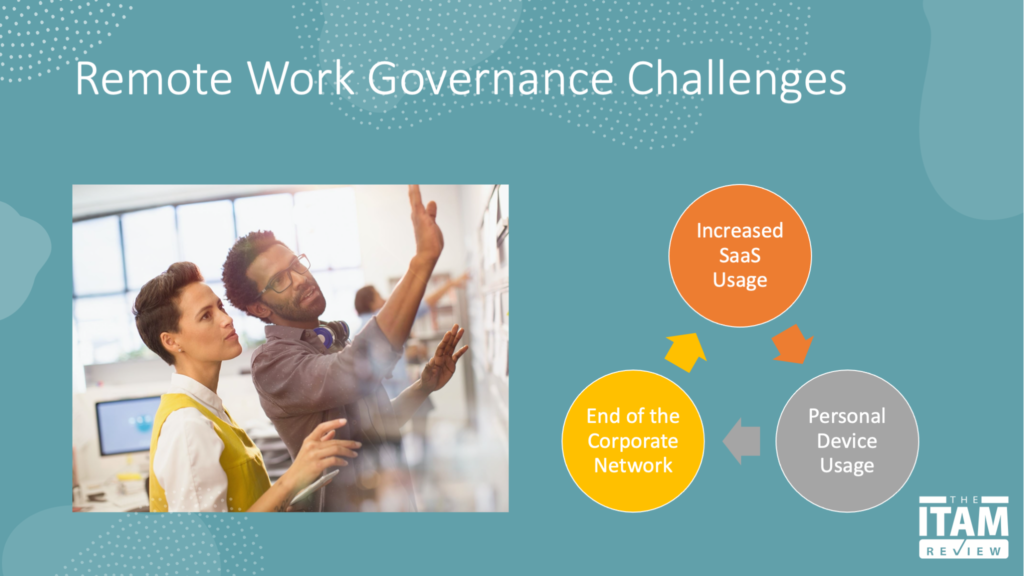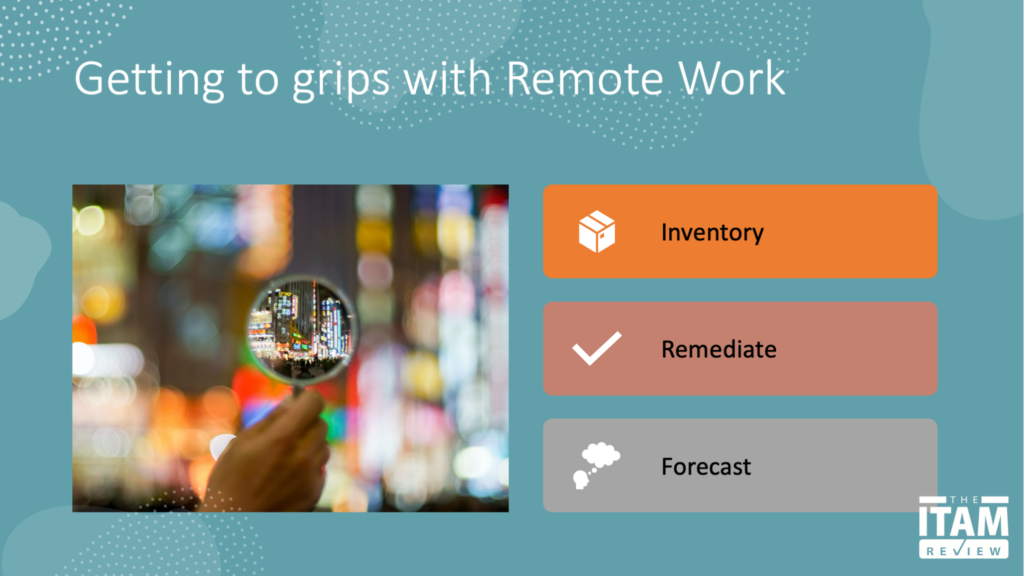A Guide to Governing Remote Work
 ITAM teams have a critical role to perform in governing the rapid transformation we’ve seen to remote working worldwide in 2020. In this article we examine what’s changed, where ITAM teams should focus, and what you need to do to get to grips with the world of remote work.
ITAM teams have a critical role to perform in governing the rapid transformation we’ve seen to remote working worldwide in 2020. In this article we examine what’s changed, where ITAM teams should focus, and what you need to do to get to grips with the world of remote work.
What’s changed?
Starting in February 2020 organisations worldwide began to pivot towards their workforces working remotely in order to protect them from the impact of COVID-19. As spring in the northern hemisphere progressed, remote work in many countries became mandatory rather than optional. This led to technology teams delivering change more rapidly than ever before and it is safe to assume that many governance processes will have fallen by the wayside in the rush to keep employees productive. I’ve heard of entire Customer Contact Centres being deployed over a weekend, and employees taking everything but the kitchen sink home with them so they could start working. Monitors, mice, keyboards, even desks and chairs were taken home.
In large organisations, IT change simply doesn’t happen this quickly. Everything is carefully planned, risk-assessed, budgeted, milestoned, and managed. Equally, projects overrun and deliverables get descoped. For the Contact Centre example I mentioned above, the previous expansion took months, not days. I’ve also worked in organisations where laptops needed signing out at the end of the working day if you wanted to take them home.
The key here is that we’ve moved from a centralised, secure, corporate office environment to an environment where your employee’s homes are the office and they’re potentially using personal devices for work. This has wide-ranging implications for the governance of technology risk and the day-to-day deliverables for an ITAM team. For me three trends sum up the changes we need to adapt to.

The end of the corporate network?
For the past three decades of client/server personal computing, companies have relied on secure, firewalled, segmented, & managed corporate networks to conduct business as safely and securely as possible. Devices were authorised centrally to access those networks and data often flowed relatively unencumbered across them. A huge raft of IT Management tools developed to detect users, devices, and activities running on corporate networks, including IT Asset Management toolsets. In the remote working world in many cases our corporate network is now the internet, and in some cases it’s personal home networks and personal devices connecting without using a VPN. This means that those IT Management tools have a more difficult job to do.
Acceleration of SaaS solutions
End user software in the PC era was designed first and foremost to run on corporate networks. More importantly for IT Asset Managers, it was licensed that way too.
For example, Microsoft base some license terms on the number of devices you own and manage. Device-based license terms assumed that a software license would be deployed solely on devices owned by the organisation with perhaps some concessions allowing non-concurrent use on portable devices. For much of the 2010s this led to difficulties in managing the less centrally-controlled networks that were being driven by rises in mobile computing power and a growing preference for “bring your own device” deployments.
Many software publishers have addressed this by moving to per-user licensing and transitioning away from the typical per-device perpetual model. Whilst SaaS spending grew in high single-digit numbers year-on-year during the late 2010s, this has accelerated in 2020 in support of remote working. Zylo report that spending on SaaS solutions increased by 25% in 2020 Q2, and this trend is likely to continue as remote working beds in for the long run.
Use of personal devices
Hardware resellers and ITAD remarketers reported unprecedented demand for laptops and remote working hardware (keyboards, webcams, etc.) in Q2 2020. This led to pressure on global supply chains – not least because Chinese factories were closed in many areas for several weeks. In the UK we saw stories of public sector organisations such as schools and healthcare scrabbling around for laptops to enable their staff to work from home and this led to personal hardware being authorised for corporate use. The popularity of solutions such as Google Classroom drove sales of Chromebooks and this was also reflected by sales growth versus laptops. Google reported 127% sales growth for Chromebooks vs 40% for laptops in Q2 2020 for the US market.
What these trends mean for IT Asset Management teams
There are short, medium, and long-term impacts of these trends on our activities as IT Asset Managers.
Short term
In the short term we have a substantial clean-up job to do. We need to track down all those existing assets that left the building in March/April. We need to ensure that new devices procured to support remote working are being discovered and inventoried. We need to think about what’s in scope in terms of HAM. Do we care about tracking mice and keyboards? What about monitors, desks, and chairs? If we do, how are we going to discover and inventory them? This also applies to managing personal devices not running on the corporate network. Is our current discovery technology able to discover these device classes and deployment scenarios? Are we even allowed to inventory or manage a personal device? Can we discover SaaS applications, including free applications such as the free version of the now ubiquitous Zoom?
Medium term
With a better idea of our hardware estate we can move on to assessing the licensing impact. This will require a review of your licensing agreements for perpetual software. Are you licensed to use company-owned licenses on personal devices? If a user has a desktop sat in an office but has now been provisioned with a laptop and is working from home, what impact does that have on license compliance? Are there any territorial restrictions applicable to end-user software? Check your agreements, don’t assume it’s going to be OK.
In the medium term we also need to prepare forecasts for FY21 and beyond. Remote working is here to stay and it’s expensive – both for hardware and software. For example, is it ITAM’s responsibility to manage the cost of broadband and mobile phones for remote workers? During our recent HAM webinar David Foxen noted that he’s seeing organisations asking employees to foot at least some of the bill for remote working kit, on the understanding that they get to keep it when they leave the organisation. In Spain it is a legal requirement for companies to cover all remote working expenses for employees working from home for more than 30% of the working week (https://english.elpais.com/economy_and_business/2020-09-22/spains-new-decree-on-working-from-home-everything-we-know-so-far.html). Whichever approach your organisation takes to paying for remote work there is a requirement for ITAM to manage the cost and risk of the associated hardware and software.
Medium term is also a good time to review your software estate to identify potentially redundant applications. Conference room software and hardware is amongst the most expensive end user computing categories. Are there opportunities to cease contracts or pause subscriptions whilst your office is empty?
Long term
As noted above, there is a continuing trend towards deploying subscription-based software (SaaS). Are your ITAM processes and tools capable of managing SaaS to the same standards applied to perpetual software? Remote work means that organisations lean heavily on SaaS solutions and it is therefore essential that they’re managed correctly. In addition to conducting an ITAM tool capability assessment you will also need to update policies and processes to take account of this new deployment scenario. Are you going to take tight control of SaaS usage or will you provide guidelines for departments sourcing their own solutions? How will you manage budgets and renewals for SaaS? Most organisations will see a significant increase in end-user software spending in FY21 and beyond. This presents ITAM teams with an opportunity to step forward and help Finance get to grips with the budgetary impacts of SaaS.
Hardware refresh cycles should also be considered for the long term. In the world of remote work, the mass department-level refresh approach no longer makes sense. Logistics are challenging and expensive, and you also need to consider the hygiene aspects of hardware coming back to the central office. We already know that laptops are more expensive to buy than desktops but you must also take into account that they’re typically less repairable and have expensive batteries that will die within two-three years, even if the device is permanently attached to power in someone’s home office. Long term you will be spending far more on hardware, and also on logistics to deploy, service, and reclaim hardware assets.

Conclusion
As the saying goes, with change comes opportunity. Remote working is undoubtedly an opportunity for ITAM teams to shine. It’s our bread and butter – knowing which software is running on which device, who is using it, and potentially even where it is being used. At even that basic level we have a lot to bring to the table for key stakeholders such as Finance & IT Operations. By looking longer term we enable strategic decision making and provide predictable costs to enable better financial planning. And there is also the opportunity to make our colleagues lives just that little bit easier by ensuring that they have the hardware and software they need to do their job, delivered securely, and at the right price.
More from ITAM News & Analysis
-
Software Vendor Insights: What do the numbers tell us about the opportunities for ITAM negotiations?
What software vendor insights can be gained from the latest financial results from Amazon, Google, Broadcom, Salesforce, IBM and SAP? An important part of ITAM is paying close attention to the health of the companies we ... -
Flexera is first SAM tool vendor verified for Oracle E-Business Suite applications
Flexera has announced that it has been verified as the first software asset management (SAM) tool vendor for Oracle E-Business Suite applications. Almost anyone with an Oracle estate will be familiar with the company’s License Management ... -
ITAMantics - March 2024
Welcome to the March 2024 edition of ITAMantics, where George, Rich and Ryan discuss the month’s ITAM news. Up for discussion this month are. Listen to the full ITAMantics podcast above or queue it up from ...